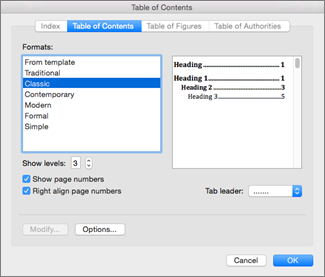Word For Mac 2011 Delete Table Of Contents
By As you fill in a table in Office 2011 for Mac Word document, you may discover you need more rows or columns, or perhaps you will want to merge some cells to enhance the layout. When you click anywhere within a table, the Table Layout tab displays on the Ribbon. Displaying gridlines and setting properties in Word tables The Settings group of Table Layout tab has only two buttons: • Gridlines: Toggles grid lines on and off. • Properties: Displays the Table Properties dialog, described later in this chapter. Adding a row or column to a table in Word 2011 Click in your table and then click an appropriate button from the Rows and Columns group on the Table Layout tab. Each time you click a button, a new row or column is added relative to the selected table cell. Pressing Tab in the last cell of a table adds a new row.
Deleting a row, column, or cell in a table Click in your table and then select a cell, row, column, or drag over the desired cells. Then click the Ribbon’s Table Layout tab, find the Rows and Columns group, and click the Delete button. A menu displays. Choose from the following: • Delete Cells: Deletes the selected cell or cells. • Delete Columns: Deletes the selected column or columns.
• Delete Rows: Deletes the selected row or rows. • Delete Table: Deletes the entire table and all of its contents.
Merging and splitting tables in Word 2011 The Merge group on the Table Layout tab offers the following options: • Merge: Select a range of cells and then click this button to remove the cell borders to create a single, larger cell. • Split cells: Select a cell or range of cells and then click this button to display a small dialog where you specify how many cells to split the selection into.
• Split table: Select a cell and then click this button to split the table into two tables. The table breaks above the selected cell. Automatically adjusting cell size in a table You can adjust cell sizes automatically using the buttons in the Cell Size group of the Table Layout tab. The three formatting options are: • AutoFit • Distribute Rows: Select two or more rows and then click this button to make the row height uniform for the selected range using the average height of the rows selected. • Distribute Columns: Select two or more columns and then click this button to make the column width uniform for the selected range using the average width of the selected columns. Aligning table cell contents Unless the content of your cells fits exactly, there’s room within cells to position the contents. • Align: Select a cell or cells and then choose a content alignment option from the pop-up menu.
• Direction: Select a cell or cells and then choose a text direction from the pop-up menu. • Margins: Displays the Table Options dialog that lets you specify how much space to have around the content within the selected cell or cells. How to change digital output to aux input for mac. Sorting, calculating, and converting tables When data is arranged so that the top row, and only the top row, is the column labels, and there are no merged cells, Word can do some common spreadsheet functions with your data. • Sort: Displays a Sort dialog.
My face tends to get oily so easily. And i need to know what face products i should use for my face. Mac loose powder for oily skin.
• AutoSum: If you have a column containing numbers that you want to add up and put the total in a cell at the bottom, here’s what you do: • Click into the empty cell at the bottom of your column containing numbers. • Click the AutoSum button. Driver for mac vupoint solutions photo converter. • Repeat Header Row: Click into the first row of your table and then click this button so that when your table spans more than one page, the header is replicated on the top row of each page.
• Convert Table to Text: Click to remove all the table elements and leave just the text separated by tabs.

Your 'table' is a Table of Contents that doesn't employ a TOC field, which is what Word would use to create one. Provided you apply the appropriate Heading Styles to your document's headings, you should be able to delete the one you now have and use Word's own Table of Contents tools (i.e. To set up a Table of Contents in Word for Mac 2011 I give everything a style, then: Go into Document Elements on the ribbon. Select Table of Contents -> Options.